How To Make Soft Rasmalai At Home
Jul 12, 2014, Updated Sep 10, 2021
Popular Indian Sweet - Indian Cottage Cheese Dumplings Soaked In Sweetened Thickened Milk Flavored With Saffron & Cardamom
This post may contain affiliate links. Please read our disclosure policy.
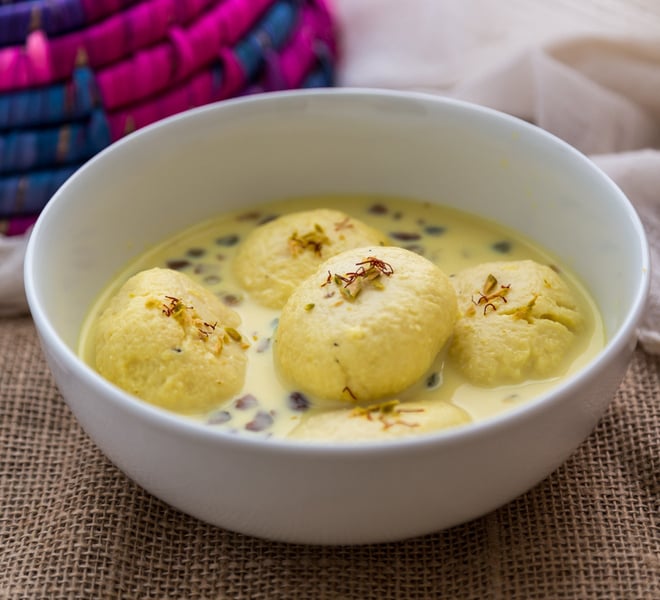
Rasmalai is my favorite Indian sweet by miles. As a kid I wasn’t very fond of sweets but Rasmalai was my absolute favorite. Maybe because it’s so delicious or maybe because we didn’t get to eat it that regularly compared to other sweets. Rasmalai is a royal sweet often served in weddings and eaten on special occasions. I already have a rasmalai recipe on my blog but I thought of making a separate post to talk about how to make perfectly soft rasmalais at home. I hope it will be of some help to the readers.
There are two parts to Rasmalai – the rasmalai balls and the thickened milk.
Rasmalai balls: To make rasmalai balls the milk is first boiled and and then curdled by adding lemon juice or vinegar. After draining the water from the curdled milk, the protein that is left is called the “chena” or “paneer”. The chena is then mashed till it becomes smooth. Small balls are then made from that chena and dropped in boiling sugar syrup till cooked.
The thickened milk or the ras: The rasmalai balls are finally dipped in thickened milk and chilled before serving. To make the “ras” [syrup] full fat milk is boiled till it thickens slightly. It is then flavored with saffron and cardamom.
So now that we know what rasmalai is let’s talk a bit about how you can make them perfectly at home. The biggest problem that people face while making rasmalai at home is that the rasmalai balls often turn out hard whereas they should be totally soft and in fact melt in your mouth – that’s when you know you have made the perfect rasmalai. During my trip to India this time I made it so many times that now I feel confident in sharing these little tips which will make sure that your rasmalais turn out perfectly every time.
I will talk about these tips as we go through the step by step picture for this recipe
Method
Boil milk in a heavy bottom pan. Once it comes to a boil, switch off the flame and add 1/2 cup of water to bring the temperature of the milk down a bit. Wait for 5-10 minutes and then start adding lemon juice till milk curdles.
Point No.1 : Use full cream/whole milk to make rasmalai. Low fat or fat free will not give good results. The rasmalai balls are nothing but milk fat so you need to use full fat milk for making this sweet.
Point No. 2: Don’t curdle the milk as soon as it comes to a boil. Add 1/2 cup water and wait for 5-10 minutes till the milk temperature comes down a bit. If you curdle the milk when it’s not “super hot”, the resulting chena will be softer.
Add lemon juice till the milk curdles completely. Using a strainer drain the water and collect the chena. Rinse it under tap water so that there’s no trace of lemon juice in it. Leave it in the strainer for 10-15 minutes and then take the chena in your hand and squeeze out remaining water slowly.
Point No. 3: Even though you have to squeeze out the water completely from the chena, make sure that it’s not completely dry. The chena should feel soft and moist even after you have squeezed out the water. So don’t press it too hard else it will become dry and resulting rasmalai balls will not be soft. This step is important so do leave little water in the chena so that it feels soft and moist when you mash it.
Add cornflour and start mashing the chena till it’s smooth. Set the clock to 10 minutes and mash constantly for 10 minutes using your palm. Once it’s smooth, make small balls out of it.
Point No. 4: Mash the chena for 10 minutes, the time is crucial so don’t try to cut it down. When the chena is smooth you should be able to make smooth balls out of it.
Point No. 5: The balls when dipped in sugar syrup double in size so make the balls accordingly. I got only 8-9 balls because I was trying to make big rasmalai balls. Usually I get 16-17 balls from 1 liter of milk but of course they are smaller in size.
Heat 1 cup sugar and 4 cups water in a wide pan and wait till it comes to a full boil. Drop the balls in boiling sugar syrup and cook for 15-17 minutes. The balls will double in size by then. Take out the balls from the syrup and drop them in fresh water. If they sink to the bottom, the balls are done. They are always done by 15-17 minutes so you can skip this step if you want.
Point No. 6: Use a wide pan to cook the rasmalai balls. The balls double in size so there should be enough space in the pan for them to cook. Don’t overcrowd the pan with too many balls.
Point No. 7: The water to sugar ratio is 4:1. So for every 1 cup of sugar we add 4 cups of water. This ratio is important to get the right syrup consistency. Drop the balls in the syrup only when it comes to a full boil and the heat should be set to maximum throughout the duration of 15-20 minutes till the balls are cooking.
Point No. 8: If you feel the sugar syrup is getting thicker and balls are sticking to the bottom of the pan, then keep adding little water constantly. The balls should not touch the bottom of the pan. The syrup should always be thin in consistency. With 4:1 ratio, you will hardly need to add any water. That’s why I said this is the perfect ratio for maintaining the correct syrup consistency.
Point No. 9: Once the balls are cooked, let them cool down to room temperature. While the balls are cooling down make the thickened milk.
In a heavy bottom pan, boil 500 ml of milk. Soak few strands of saffron in a tablespoon of warm milk and set aside.
Once the milk comes to a boil, lower the flame and continue to stir the milk at regular intervals. After 10 minutes add sugar and mix.
After 20-25 minutes the milk will thicken to desired consistency, add soaked saffron and crushed cardamom. Also add finely chopped pistachios [if using]. Mix and switch off the flame.
Take out the cooled down rasmalai balls from the fresh water bowl. Squeeze and flatten lightly using your hands and put in sugar syrup for around 10-15 minutes [so that they absorb the sugar] before transferring them to milk. Squeeze the balls carefully as they are very soft and can break easily. I like to flatten the rasmalai at this stage rather than flattening them in the beginning. I feel they get cooked evenly in the sugar syrup when the balls are round in shape.
You can let the balls cool down in sugar syrup itself and then you can skip this step and transfer the balls directly to milk.
After 10-15 minutes transfer the balls to thickened milk. Chill in the refrigerator overnight or for 5-6 hours. Garnish with chopped pistachios and few saffron strands before serving.
Point No. 10: The milk should be warm when you add the rasmalai balls to it. So the balls should cool down to room temperature but the milk should be warm.
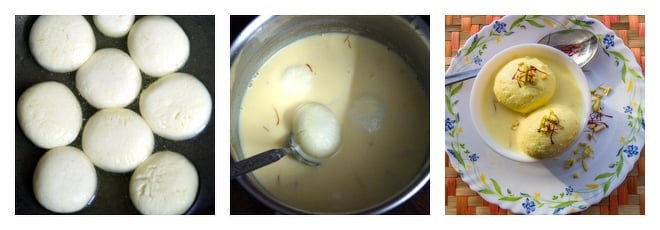

* Use real cardamom pods to get the crushed powder. Do not use the ready made cardamom powder that we get in stores, it doesn’t have the same taste as the real one.
* Rasmalai taste best when chilled overnight. Also the balls soak the milk and all flavored get intermixed well in 8-10 hours. So to serve the next day, make them a day in advance.
I hope these 10 tips help in making you the perfect soft rasmalai at home.
How To Make Soft Rasmalai At Home
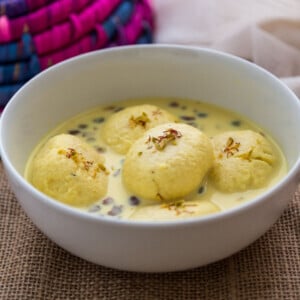
Ingredients
For the rasmalai balls
- 1 liter whole milk
- 4 tablespoons lemon juice
- 1 teaspoon cornflour
- 4 cups water
- 1 cup sugar
For the ras [syrup]
- 500 ml whole milk
- 5-6 green cardamom pods peeled and crushed to get the powder
- saffron a pinch
- 3-4 tablespoons sugar
- finely chopped pistachios
Instructions
Rasmalai Balls
- Boil milk in a heavy bottom pan.Once it comes to a boil, switch off the flame and add 1/2 cup of water to bring the temperature of the milk down a bit.
- Wait for 5-10 minutes and then start adding lemon juice till milk curdles.
- Add lemon juice till the milk curdles completely.
- Using a strainer drain the water and collect the chena.
- Rinse it under tap water so that there's no trace of lemon juice in it.
- Leave it in the strainer for 10-15 minutes and then take the chena in your hand and squeeze out remaining water slowly.
- Add cornflour and start mashing the chena till it’s smooth.
- Set the clock to 10 minutes and mash constantly for 10 minutes using your palm. Once it’s smooth, make small balls out of it.
- Heat 1 cup sugar and 4 cups water in a wide pan and wait till it comes to a full boil. Drop the balls in boiling sugar syrup and cook for 15-17 minutes. The balls will double in size by then. Take out the balls from the syrup and drop them in fresh water. If they sink to the bottom, the balls are done. They are always done by 15-17 minutes so you can skip this step if you want.
Thickened Milk
- In a heavy bottom pan, boil 500 ml of milk.
- Soak few strands of saffron in a tablespoon of warm milk and set aside.
- Once the milk comes to a boil, lower the flame and continue to stir the milk at regular intervals. After 10 minutes add sugar and mix.
- After 20-25 minutes the milk will thicken to desired consistency, add soaked saffron and crushed cardamom.
- Also add finely chopped pistachios [if using]. Mix and switch off the flame.
- Take out the cooled down rasmalai balls from the fresh water bowl. Squeeze and flatten lightly using your hands and put in sugar syrup for around 10-15 minutes [so that they absorb the sugar] before transferring them to milk. Squeeze the balls carefully as they are very soft and can break easily. I like to flatten the rasmalai at this stage rather than flattening them in the beginning. I feel they get cooked evenly in the sugar syrup when the balls are round in shape.
- Transfer the balls to thickened milk [milk should be warm].
- Chill in the refrigerator overnight or for 5-6 hours. Garnish with chopped pistachios and few saffron strands before serving.
Nutrition
Nutrition information is automatically calculated, so should only be used as an approximation.
How To Make Rasmalai at Home
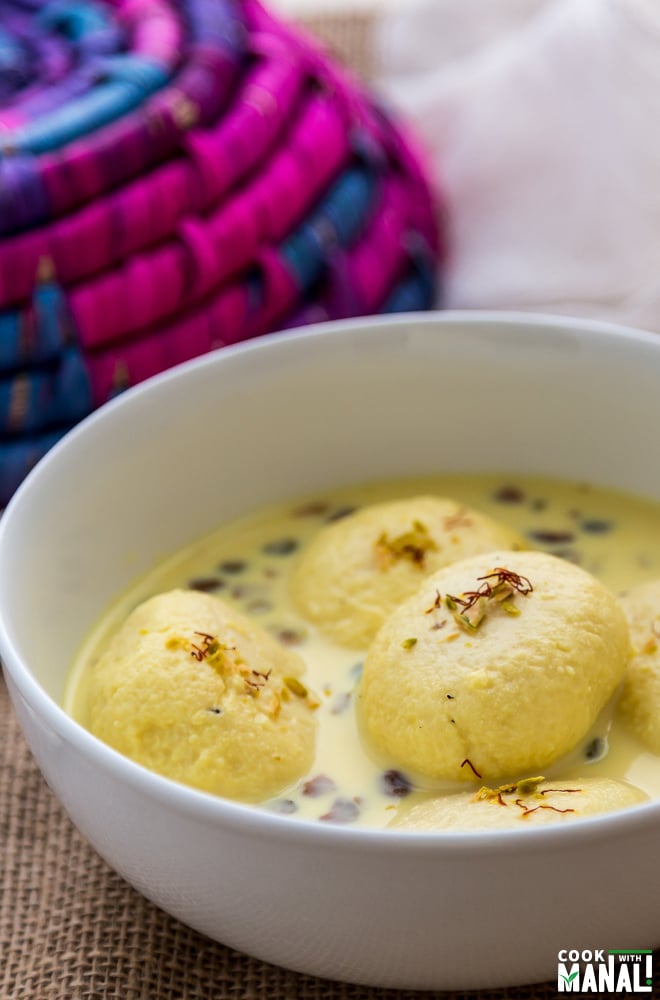
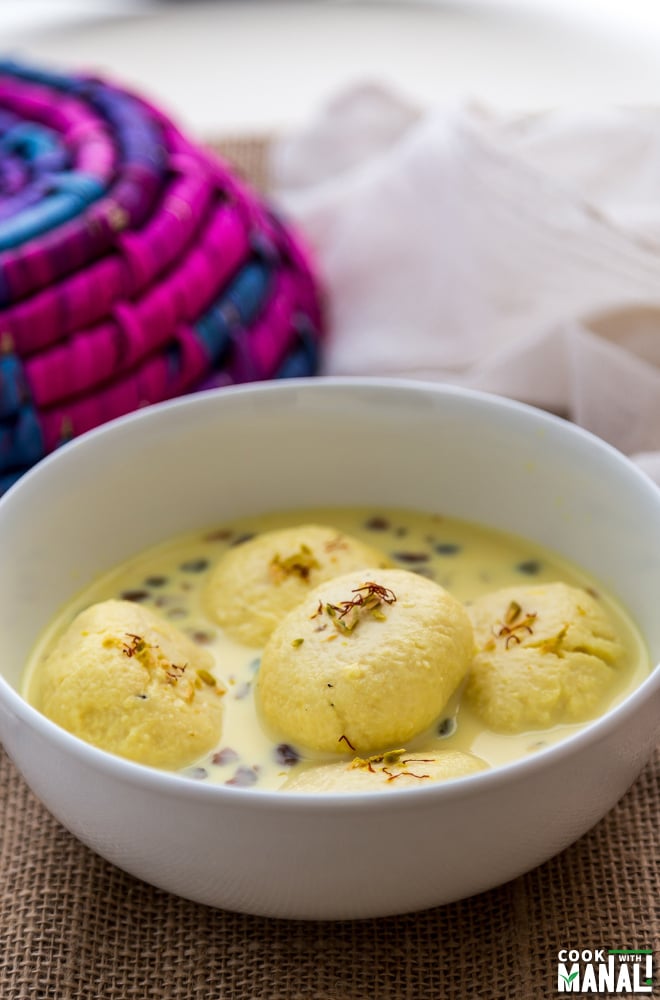
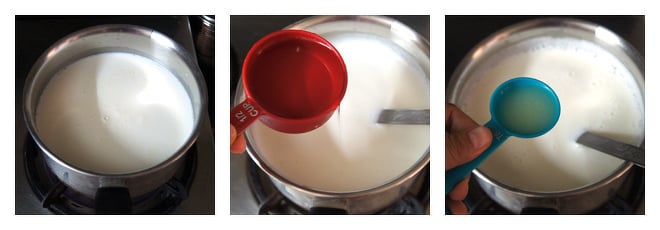
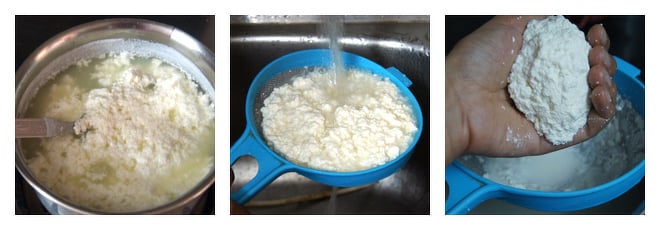
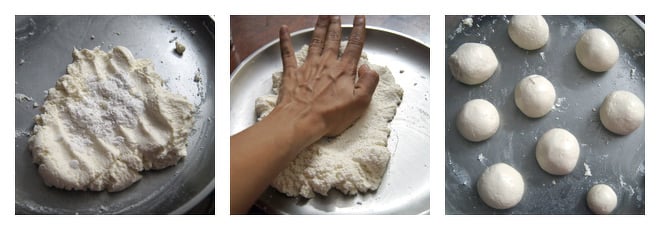
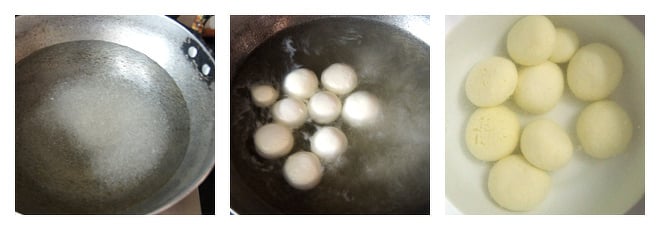
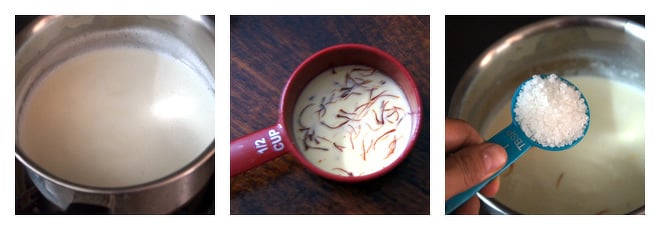
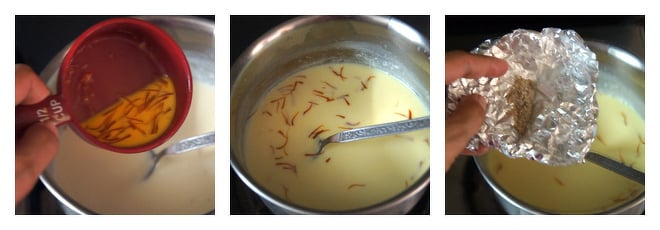
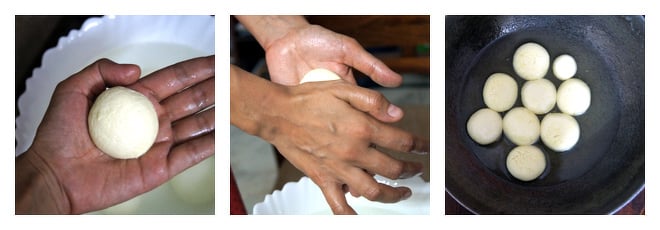
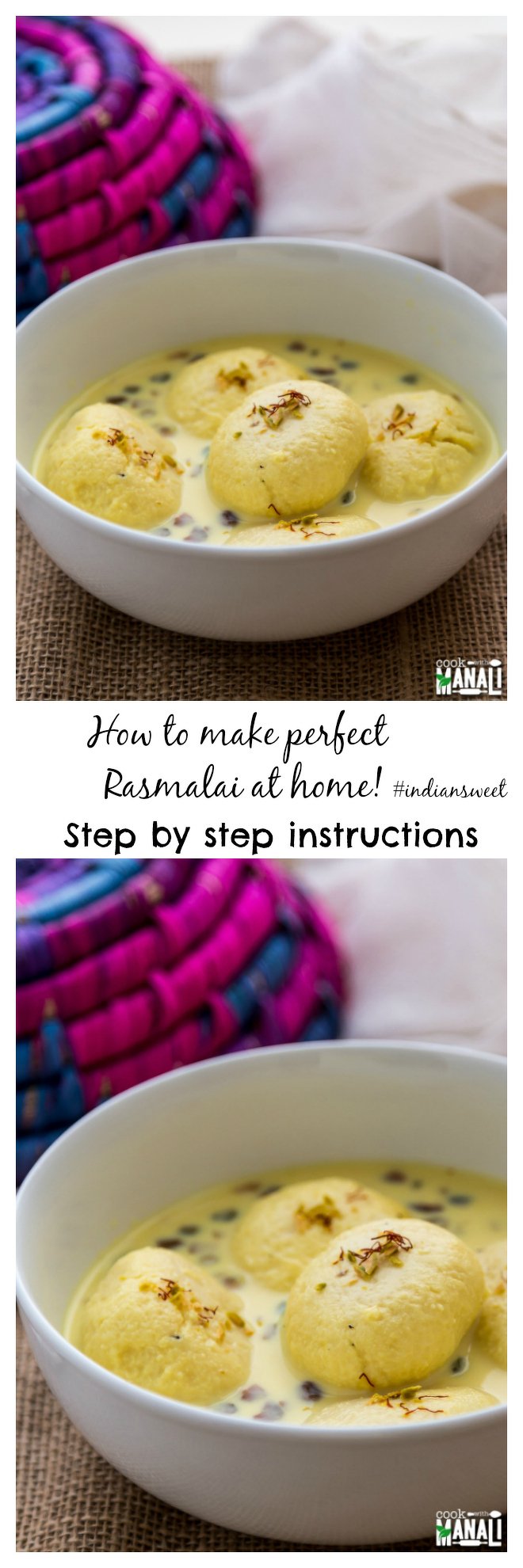

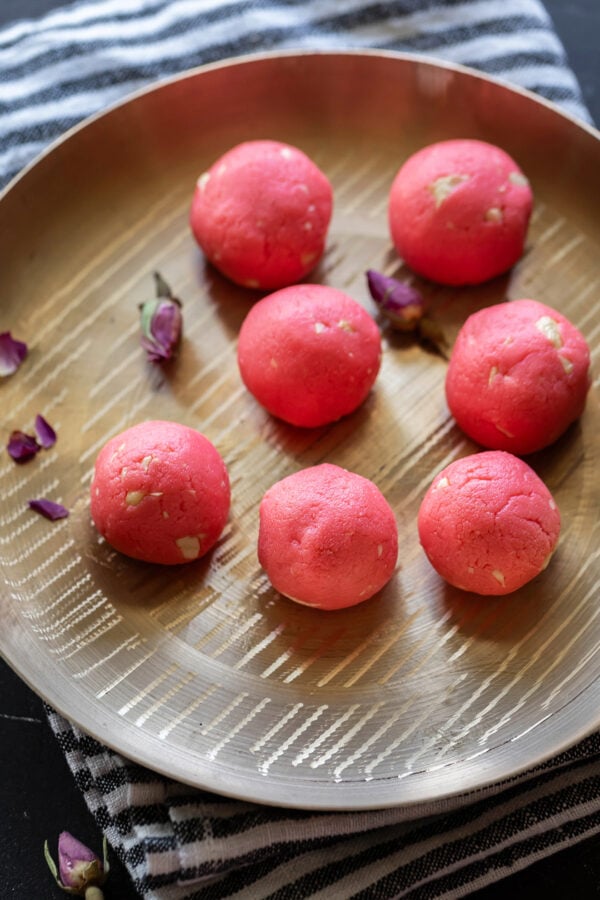
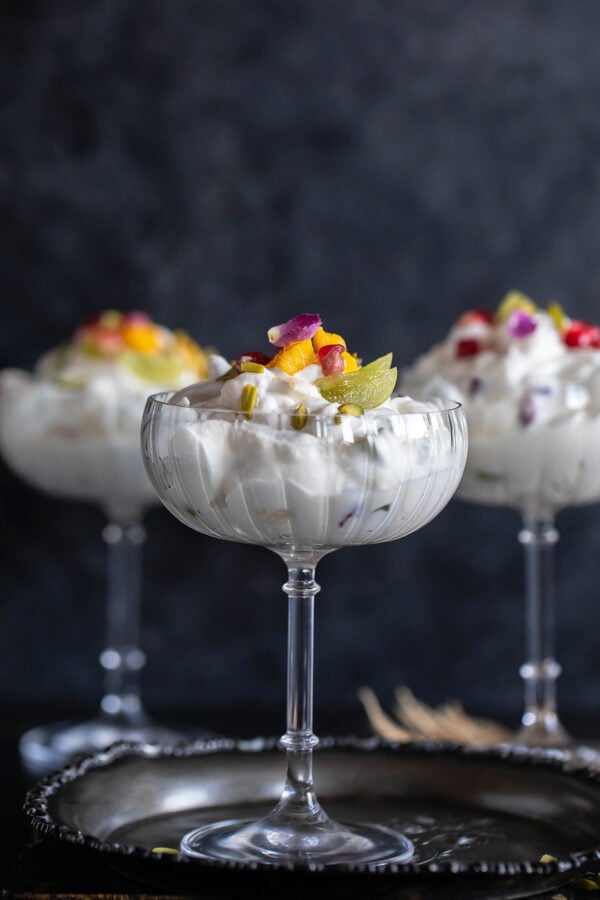
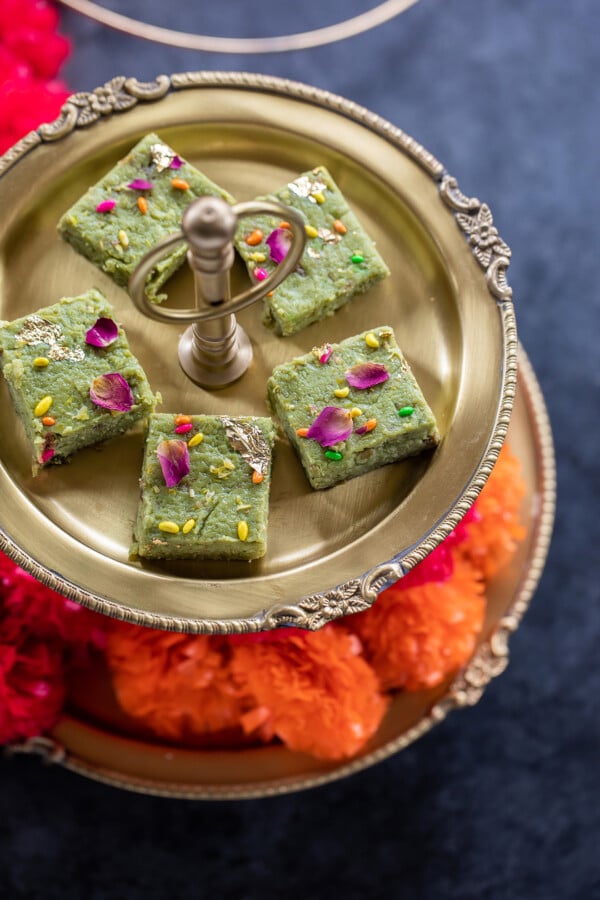
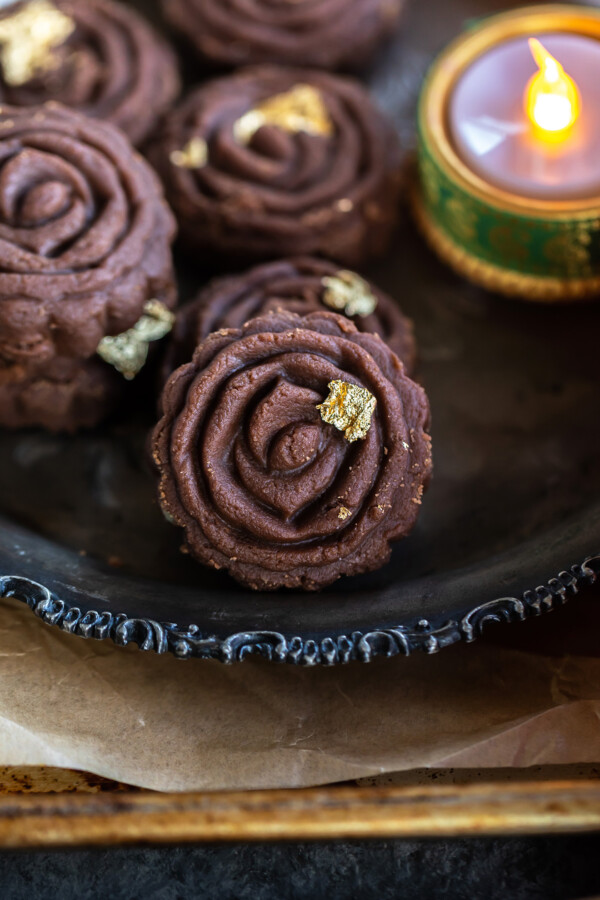









thanks manali for the recipe
The recipe seems detailed but it’s actually confusing at the point where the balls are boiled. At one instance you mention that once the balls have boiled you must drop it it fresh water to check if they are done And put them back in sugar syrup for 15 minutes:
“Take out the cooled down rasmalai balls from the fresh water bowl. Squeeze and flatten lightly using your hands and put in sugar syrup for around 10-15 minutes [so that they absorb the sugar] before transferring them to milk“
This is not mentioned in the point at all
“ Drop the balls in boiling sugar syrup and cook for 15-17 minutes. The balls will double in size by then.
Take out the balls from the syrup and drop them in fresh water. If they sink to the bottom, the balls are done.”
So re we supposed to drop the cooled down balls again in sugar syrup again or not?
I had to follow another recipe to get the correct method
yes you have to drop the ball in sugar syrup before you put them in milk.
I have tried this and it tastes amazing ❤️❤️
awesome! 🙂
I am confused so after making the rashmalai balls i am dipping them in the sugar syrup and to check if they are done im putting all of them in fresh water? (Point 11)
Because in the method of making thickened milk in point 6 it says – Take out the cooled rasmalai balls from the sugar syrup, squeeze and flatten with your hands.
So this the confusing part. So after sinking them in fresh water (point 11 in rashmalai balls )shall i put them back in sugar syrup.
Any advice ?
Kind regards
S.D
you are putting them back in the thickened milk “ras”.
Do you boil the chenna balls in pan with the lid on or off?
off but you can definitely put the lid on.
Thanks for a full proof recipe with all those little details.
Everything was in detail 💛
It turns out perfect,Thank you🤗
I made the mistake of not taking enough water out of the chena, but the taste is goergoeus! Will be making again at some point!!
Every step was good but adding cornflour to chenna made it flop…
The balls turned out hard like anything..
hard balls are because you squeezed way too much water from the chena and not from adding cornflour. Even if you skipped cornflour, your balls would have still been hard. Making perfect rasmalai takes practice.
I do not use the corn flour (I have an allergy) and they turn out perfect. No need for corn flour, honestly. No traditional recipe in India will add corn flour.
Also 10 minutes of kneeding is too much – it separated the fat and the balls turned out hard. I kneed for 3-5 minutes, not too much so the fat doesn’t separate, and do not add corn flour, and it is perfect.
I had to try it every day for a week, and watched many Bengali youtube videos (I am not Bengali, but I watched the technique) before it turned out perfectly soft and juicy. Practice does indeed make perfect!
Thank you for all your recipes, I enjoy many of them!
Thanks for sharing!
Thanks Manali I will try it again when I next buy whole milk and be more liberal with the lemon juice.
I tried to make this today and in the end I just had to throw it away. I used the correct amount of lemon juice but for some reason the milk did not separate enough. I waited a long time but it was never possible to squeeze out the water from the chena.
sometimes the milk doesn’t curdle, it has to do with the temperature of the milk or the milk quality itself. In such cases, add more lemon juice, add slowly until it curdles. If it’s still not curdling then try vinegar. That will most likely do the trick!
I agree, the cornstarch gave it a tough texture… Didnt come out well at all… Dissapointed!
the tough texture is not the result of cornstarch at all, it’s because you squeezed way too much moisture from the chena. Making the perfect rasmalai takes time and practice so please try again. Chena should feel a little moist always, it took me years to get it perfect so try again 🙂
Hello, thank you for this detailed recipe. What type of corn flour do you use? Corn meal type flour? Or do you mean cornstarch? Do you have a brand suggestion?Thanks
yes you can use cornstarch, in India corn flour is same as cornstarch
Hi Manali, I really like the detailed description you give. It made me feel comfortable to try and make my own Rasmalai. But, do you really use corn flour? Not corn starch? Because, when I tried it with corn flour today, the balls started to disintegrate as soon as I put them into the boiling syrup ?♀️ Or whatelse could I’ve done wrong? Thx.
making rasmalai takes practice, the problem is not with corn flour or cornstarch, the problem is there was too much moisture in the chena because of which balls disintegrated in the syrup. Please squeeze more water from chena and try again.
I’ve tried making Rasmalai with another recipe and failed so dismally I didn’t try it again till today and I can honestly say your recipe is so simple to follow and easy to make! I currently have it cooling in the milk and I can’t wait to try them 😁 I did add a touch more Cornflour because I had a little too much water in my chena but it still turned out soft and amazing
glad to know Akira!
Which cornflour do you usually use? I am going to make it first time, excited!!
Thank you for the recipe.
no particular brand
Hello. For the crushed cardamom powder. Do I crush just the seeds or the covering too? Thank you.
just crush the seeds
Hi Minali I made ras malai yesterday but my rasgullas were hard please help.
many reasons, most probably you squeezed way too much water from the chena. try again, it takes some practice to get it right
Can I actually just replace the dairy milk with some Oatmilk? I wanted to try a vegan recipe.
No, oat milk doesn’t work the same way as dairy in this recipe. vegan rasmalai will be a different recipe altogether and can’t be substituted 1:1 here.
Thank you 😀
Have you got any vegan Rasmalai recipe?
no 🙂
Aapki recipe bahut achi hai. Meri wife nay ghar par banaya. Thoda hard ho gayee but taste bahut acha tha. Bazar say jo hum kharidtay hai ussay lakh guna behtar thi. But thoda hard ho gayee. Aapka bahut bahut sukhriya.
hard is because you squeezed a lot of water from the chena, let it be a little moist and try again
Hi! I have two questions.
1. The recipe is for 1 liter of milk. If I want to make it with 2 liters of milk, should the amount of cornflour be doubled – 2 teaspoon instead of 1 teaspoon?
2. It came out okay the two times I tried the recipe. But, once I refrigerate it, it becomes hard. Yes, I can microwave it, and then it comes to the original form. But, is this normal for the Rasmalai (and even the Rasgullas) to become hard when refrigerated?
you can use 2 teaspoons. Hmm no it shouldn’t turn hard, maybe try squeezing chena a little less next time. it’s a fine balance that you have to find where chena is dry so that it doesn’t break in water but also still has little moisture in it so that it remains soft.
Hi, Manali I am Anshi,
I tried ur recipe but it dint turn out well they were breaking in the chena can u help me
your chena had too much moisture, that’s why. Squeeze more water from chena next time.
Great recipe Manali, the first time I made it, it turned out perfect. The second time round the rasmalai did not double in size, I did exactly the same process. What could be the reason?
Many thanks
hmm not sure why it would not work the next time, usually when they don’t increase in size it’s due to not getting enough space in the pan
Hi Manali
Firstly thank you very much for sharing your recipe, I’ve always loved rasmalai since I was a kid and due to the covid lockdown in UK I have utilised this time to learn cooking,which I enjoy very much.
This time I followed your recipe for rasamalai as my usual method always ends up with the balls being a bit hard and chewy. I’m pleased to report the balls came out perfect with your method, very soft and melt in your mouth!
The only thing which didn’t for me in your method was cooling the milk for 10 minutes before curdling it, it just wouldn’t curdle once I let it cool down for 10 minutes so I had to reheat it to enable to curdle. Any ideas or comments on this, in case I did something wrong?
The other thing is the balls don’t come out fluffy but rather flat, and advice would be welcome. Thank you.
let it cool for 5 minutes only then and then curdle it, adding acid to a little less hot milk helps in getting super soft chena. give ample space in the pan to each ball only then they will have a nice shape
Hi,
Would you please tell why should I mix cornflower with chana and what should be the ratio of cornflower and the chana.
Thank you
the cornflour is added to bind the chena. the ratio is mentioned in the recipe.
HI Manali,
Can i add rice flour instead of cornstarch to the recipie?
all purpose flour would be better
When I made rasgulla it was very spongy. I cooled it down at room temperature in sugar syrup And then transferred to the milk . But when I transferred them in milk and refrigerated they become little hard and also milk was not absorbed till the centre. What could be the reason. How to fix this problem
few things- hard because you drained too much moisture from the chena and next looks like you over-cooked the rasgullas.
Thanks for the wonderful recipe… You have mentioned tips that helped me understand where the rasmalai can go wrong! My 2nd attempt and this time I used ur recipe. Has come out well!! Thanks ☺️
yay so glad!
Hi,
Chena is too soft n sticky and unable to make balls. What to do?
hmm it had to be hanged more, looks like it has too much moisture. You can try adding some cornstarch or flour to it and see if you can make balls
Hey
Thank you for the tips
I tried it… and it comes out to be amazing…. thank u?
The recipe is missing something. Most other recipes calls for boiling the Rasmalai in sugar syrup for less than 10 minutes and covering the pot with the lid while heating the Rasmalai in the syrup. Your recipe called for 15-17 minutes…In boiling syrup…and there is no mention of whether we should cover the pot or not. My Rasmalai came out hard. I was so disappointed because the Rasmalai were hard. I think you should clarify.
There’s nothing missing in this recipe. I have shared how I make it and it comes out perfectly for me every time. Also over the years, hundreds of people have made this recipe successfully (please read the comments). If I haven’t mentioned that pot should be covered that means it wasn’t covered, there’s also a step by step picture which clearly shows that. This recipe is in depth and I don’t think I need to clarify anything more. Your rasmalai is hard because making a good rasmalai is an art which takes practice. You probably squeezed way too much moisture from your chena and that’s why it’s hard.
If I wanted to make a smaller batch.. would halving all the ingredients be okay? Or do you have a suggestion for a better way to do it? I’m nervous to try bc I’ve never made anything like this before. But I love the rasmalai I’ve tried in restaurants so I went and bought the ingredients! Thanks for this recipe 🙂
give it a go, the only thing I would like to say is that learning to make perfect rasmalai takes time (it’s a skill) so don’t be disheartened if you don’t get it at right at the first try (even after following everything in the recipe).
Thanks for this lovely and yummy recipe…. but can you tell me how will i get to know if my rasmalai balls are ready to transfer into the milk..
cook them for the time mentioned that they will be ready by then.
How long can we store it
rasmalai is good for 3 days, since it’s a milk based product it doesn’t have a long shelf life
I have made it using the recipe and it tastes delicious but is quite thick. The chena are soft but I think I must have overcooked the milk as it reduced drastically and is now hard. Can I add anything to it to make it runnier or will this ruin it? Maybe i could serve with some cream instead but then it would not be an authentic dish
you mean the rasmalai balls are hard or the milk is thick or both? Unfortunately now that it’s cooked, you can’t do anything about the balls. Hard balls usually means that you squeezed way too much moisture from the chena. if the milk is thick, you can definitely add more milk to it to thin it out.
Hi, thank you for sharing the recipe! I tried making the Chena, left it to dry out the water using Muslin cloth for 15 minutes, and squeezed it out but my chena was still sticky. Tried it again the second time but for 50mins, it was sticky again. I could form it into a ball but it wasn’t the doughy/dry consistency. End result, my rasmalai was quite soft and little chewy like a subtle jelly texture. What should I improve on?
did you use cornstarch? that will help. Chewy means you over-cooked the balls.
Hi Manali,
What can we do with the sugar syrup used to boil the balls? Can you suggest anything to re-use the syrup?
I made small balls assuming they will double in size but they didn’t double up much. What could be the reason?
use in making sweet paratha or shakar para? If balls didn’t double in size, maybe they didn’t have enough space in the pan.
While boiling the milk it has become very thick…its like rabri …its very thick wat is the reason?
you cooked the milk more than needed, that’s why. It only needs to get slightly thickened.
While kneading chena, it turned into white butter like consistency. I was not able to make balls out of it
What could be the reason?
too much moisture in chena
same happened with me…what should i do with butter thing…should i now put in muslin clothe and squeeze? i have added cornflour and kneaded completely
try keeping it in fridge and then try again after few hours
Hi, when I added lemon the Chenna was very very soft….so when I started to mash it it was like purée….why is that?
Thanks
too much water in the chena, use a muslin cloth, squeeze it well.
Thank you, 3rd time lucky! It ended up tasting lovely. Only thing is very slightly firm in the centre but I think I squeezed too much after soaking in syrup. Will try again next time.
Thanks
I have tried my hands on it, every went on well… however for some reason, the malai balls remained hard.. would you like to throw some light on this please!! Thank you
either you didn’t knead the chena well or you squeeze too much water from the chena. It needs to be little moist still.
Thanks for the recipe. The Rasmalai balls turned out to be little hard not fluffy, they didn’t expand as much. Do you know what might have gone wrong
you squeezed too much moisture from the chena hence they were hard.
is there any way to rescue the Chenna if it’s too moist? I added the cornstarch, but it’s so moist, it’s gooey! Cant even form into balls!
try hanging it for some times, or keep in fridge for a while and then try again
Can we you any other flour instead of corn flour and which one plz tell…
skip it!
Is corn flour the same thing as American corn starch?
yes!
Hi, all my balls have dissolved in the syrup mixture… can I rescue this? …please help ??
Unfortunately no, your chena had a lot
More moisture than needed and hence they dissolved in sugar syrup. I would suggest make kheer out of it now. Add crumbled chena to slightly thickened milk add some nuts.
Thank you for quick response Manali ?? … I will make kheer instead & will try again to make Rasmalai ?☺️
Thank you for the perfect rasmalaai recipe, Manali! My preparation was just perfect though I had made it for the first time.
I had some doubts but all were cleared while I went through the comments section. ?
I will definitely refer your channel for other recipes.
awesome!
Hi. How do i use the disintegrated balls to make kheer? I prefer not to waste food, but I had too much fluid and so the balls broke up in the sugar water ??
Or another recipe u know so I’m not wasting the curd and sugar water ?
Your balls had too much moisture in them and hence they broke and got disintegrated. You can thicken some milk , flavor it with cardamom and saffron, add sugar and then add these disintegrated balls to it. Serve chilled.
Hi. Thank you for sharing the recipie. My rasmalais were soft but a little chewy, not melt in the mouth kind. What could be the reason?
Thank you once again. They came out great for the first try though
looks like you overcooked them a bit 🙂
Oh ok. Will take care of it there next time. Also, the rasmalais almost tripled in size within 10 min in the sugar water. And when I put it on medium flame they reduced in size again. Why would this be?
why did you put them back on heat again? Once cooled, they just need to be put it warm milk and that’s all. They don’t need to cook again.
No no while cooking them for 15 min, that time only I started on high heat and they tripled in size, since the water was boiling a lot I reduced the flame a bit so they also reduced in size.
looks like you over crowded the pan. Add less balls next time, they need space to expand and then maintain the shape. If there isn’t enough space, they will shrink.
Can I use cashew nuts instead of pistachios?
sure
Hi ,
I have one confusion here. After boiling the balls in sugar syrup , should we first cool them down in fresh water and then again cool down in sugar syrup before transferring to milk ? Or should the balls be left in sugar syrup only and let both the balls and sugar syrup cool down together ?
they don’t need to cool down completely, the fresh water thing is only to test if balls are done. You can left them in sugar syrup too, once cooled a bit transfer to thickened milk (the milk needs to be warm).
Thanks a lot Manali. I made these today and turned our simply delicious!! Such a good recipe and most importantly the key points were so much helpful in overall understanding of the recipe at each step. Wish I could share a picture here !!
My rasmalai was not so soft. What could be the reason
you extracted way too much moisture from the chena. It comes with practice, the right stage where you need to stop. You will get it next time!
can you put d pics of d stages in this recipe. I tried but I lost a lot of d curdled milk while straining.
the recipe has all the step by step pictures, please check the post
Why does the balls melt in boiling sugar syrup?
too much moisture in chena
Can I use rasgulla to make rasmalai ? Your opinion pls
yes, make the ras and then add rasgulla to it (after draining the syrup)
Thank u so much…the recipie turned out so perfect. My little daughter enjoyed a lot.???
Thank you so much …. The recipe is so perfect !
One question …can I use vinegar instead of lemon juice and get the same result?
yes but I prefer lemon. Vinegar results in more solid chena and for sweets we need soft chena.
Hi Manali!
Thanks for sharing this recipe!
I have a question about the amount of milk for the chena. If I use heavy whipping cream instead of whole milk, since there is much more fat, can I get away with using much less? How much cream would you recommend using in place of the 1 liter of whole milk?
Cheers!
you cannot make chena with heavy whipping cream or at least I don’t know a way to make it. Chena is fresh curd cheese made by adding an acid to hot milk and you cannot do with cream.
Very nice recipe. I tried this at home at everyone loved it. Thanks for sharing.
Manali ji your recipe is awesome. Thanks.